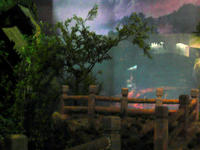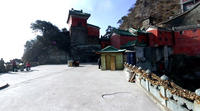You are in: Asia -> China -> Ancient Building Com... , and traditional search or Image Gallery will yield results of this site only
Ancient Building Complex in the Wudang Mountains
| Site number: | 705 |
|
| Type of site: | Cultural | |
| Date: | 7th-17th c. | |
| Date of Inscription: | 1994 | |
| Location: | Asia, China, Hubei Province, Danjiangkou City | |
Up to 75 images are shown here. Click on each for more details or on Image Gallery for more images.
| Description: | Exemplifying the architectural and artistic achievements of China's Yuan, Ming and Qing dynasties among this group of secular and religious buildings are the palaces and temples which form the the very center of it. The site is positioned in the scenic valleys and on the slopes of the Wudang Mountains within the Hubei Province. Though it was constructed as an organized complex during the Ming dynasty of the 14th–17th centuries, it encompasses Taoist buildings dating back as early as the 7th century. The site characterizes the highest standards within the art and architecture of China for over a period of nearly 1,000 years. --WHMNet paraphrase from the description at WHC Site, where additional information is available. For 360 degree imaging of this site, click here. | |
| The Wudang Mountains (simplified Chinese: 武当山; traditional Chinese: 武當山; pinyin: Wǔdāng Shān), also known as Wu Tang Shan or simply Wudang, are a small mountain range in the Hubei province of China, just to the south of the manufacturing city of Shiyan. In years past, the mountains of Wudang were known for the many Taoist monasteries to be found there, monasteries which became known as an academic centre for the research, teaching and practise of meditation, Chinese martial arts, traditional Chinese medicine, Taoist agriculture practises and related arts. As early as the Eastern Han Dynasty (25-220AD), the mountain attracted the Emperor's attention. During the Tang Dynasty (618-907), the first site of worship - the Five Dragon Temple - was constructed. The monasteries were emptied, damaged and then neglected during and after the Cultural Revolution of 1966-1976, but the Wudang mountains have lately become increasingly popular with tourists from elsewhere in China and abroad due to their scenic location and historical interest. The monasteries and buildings were made a UNESCO World Heritage Site in 1994. The palaces and temples in Wudang, which was built as an organized complex during the Ming Dynasty (14th–17th centuries), contains Taoist buildings from as early as the 7th century. It represents the highest standards of Chinese art and architecture over a period of nearly 1,000 years. Noted temples include the Golden Hall, Nanyan Temple and the Purple Cloud Temple. --Wikipedia. Text is available under the Creative Commons Attribution-ShareAlike License. For 360 degree imaging of this site, click here. | ||
| Source: | http://whc.unesco.org/en/list/705 | |
| Reference: | 1. UNESCO World Heritage Center, Site Page. | |













